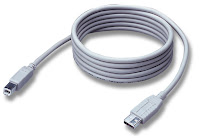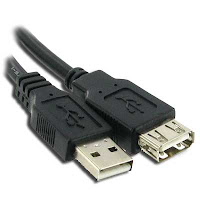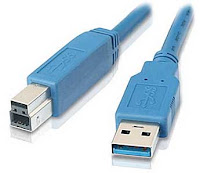USB History
USB (Universal Serial Bus) is an industry standard that defines the cable, connectors and protocol used for connection, communication and p...
https://findgadgetreview.blogspot.com/2012/02/usb-history.html
USB (Universal Serial Bus) is an industry standard that defines the cable, connectors and protocol used for connection, communication and power between computers and electronic devices.
USB was designed to standardize the connection of computer peripherals such as keyboards, mouse, digital cameras, printers, portable media player, disk drives and network adapters for PC (Personal Computers), both for communication and electrical power supply, but now it is also in devices such as smartphones, PDAs and consoles video games. USB effectively replaces the previous range of interfaces such as serial and parallel ports, and a separate charger for portable devices.
In 2008, there were 2 billion USB devices sold per year, and about 6 billion devices have been sold.
Seven USB development company that started in 1994 are: Compaq, DEC, IBM, Intel, Microsoft, NEC and Nortel. The goal is to make fundamental easier to connect external devices to your PC by replacing a lot of connectors on the back of the PC, addressing the usability problems of the existing interface, and simplify software configuration of all devices connected to USB, as well as allowing greater data rates for external devices. The first silicon for USB made by Intel in 1995.
The original USB 1.0 specification, which was introduced in January 1996, defined the "Low Speed" (1.5 Mb/s) and the "Full Speed" (12 Mb/s). The first version of the widely used USB 1.1, which was released in September 1998. 12 Mb/s data rate used for high-speed devices such as disk drives, and 1.5 Mb/s data rate for a device like a joystick.
USB 2.0 specification was released in April 2000 and standardized by the USB Implementers Forum (USB-IF) at the end of 2001. Hewlett-Packard, Intel, Lucent Technologies (now Alcatel-Lucent), NEC and Philips together - each led initiative to develop a higher data transfer rate with generated specification to achieve 480 Mb/s, 4x much increase over the USB 1.1 specification.
USB 3.0 specification was published on November 12, 2008. The ultimate goal is to increase the speed of data transfer up to 5 Gb / s, also reduce power consumption, increase the output power, and should be compatible with USB 2.0 (also known as backward compability). USB 3.0 has a new higher speed. This new version also called SuperSpeed. A device that equipped with a USB 3.0 first presented in January 2010.
USB version from the beginning:
- USB 0.7: Released in November 1994.
- USB 0.8: Released in December 1994.
- USB 0.9: Released in April 1995.
- USB 0.99: Released in August 1995.
- USB 1.0 Release Candidate: Released in November 1995.
- USB 1.0 Released in January 1996: Has a speed of 1.5 Mbit / s (Low-Bandwidth) and 12 Mbit / s (Full-Bandwidth).
- USB 1.1 Released in September 1998. Fixes a problem in version 1.0.
- USB 2.0 Released in April 2000: Has a higher maximum bandwidth, 480 Mbit / s (60 MB / s) (now called "Hi-Speed"). Further modifications to the USB specification has been done through the Engineering Change Notices (ECN).
- USB 3.0 has a transmission speed of up to 5 Gb / s, which is 10 times faster than USB 2.0 (480 Mbit / s). USB 3.0 is significantly reducing the time required for data transmission, reducing power consumption, and is compatible with USB 2.0 downward. USB 3.0 Promoter Group announced on 17 November 2008 that the USB specification version 3.0 has been completed. This move effectively opens great opportunities for hardware developers for implementation in future products.




